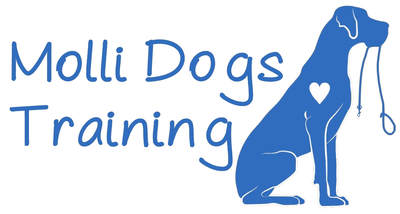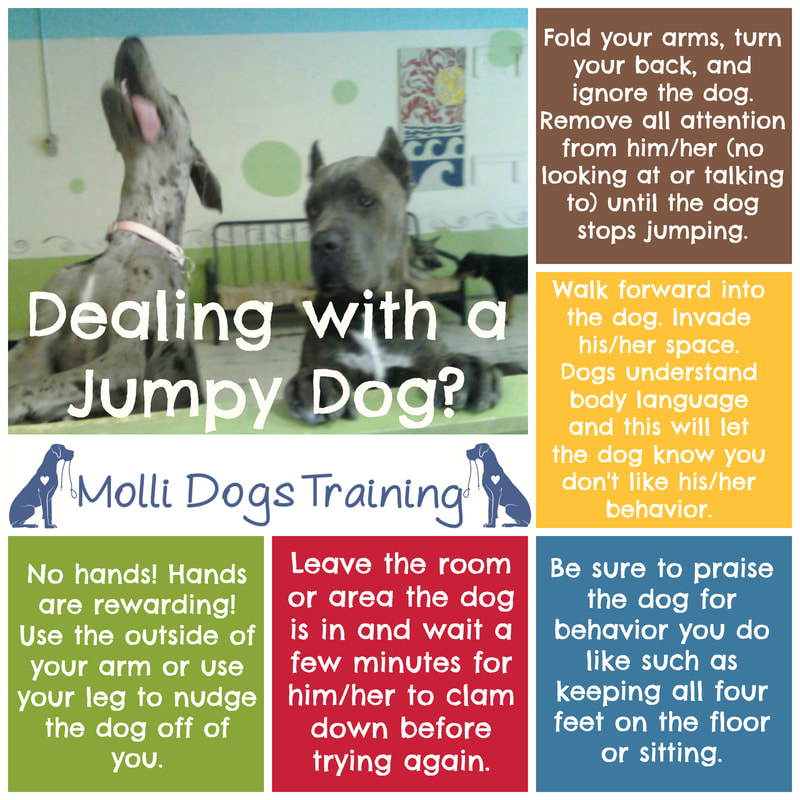Jumping Up
Jumping up on people is a common behavior that most dog owners will experience at one point in time or another. Dogs jump up on us because they are excited, they love us, and they want our attention! While this is a very natural and acceptable behavior to dogs, it is generally not considered acceptable to people.
|
It's easy for people to try to teach their dog that they don't want them to jump up, but be sure to be teaching the dog what behaviors you do like and want him to be doing instead, such as sitting. Once all four paws are solidly on the floor or if the dog sits or lays down, lather on that praise! If you don't teach the dog what behaviors you like and what will work to get attention from you, the dog will likely continue to try to get attention using behaviors you don't like, such as barking, pawing, or tugging on clothes.
When working with a jumpy dog, remember to not use your hands to push the dog off you. Hands are rewarding to dogs. Hands are what feed them, give them treats, pet them, and play with them. If you use your hands to try to push the dog off he will likely just think you are playing a game and the behavior may escalate. In addition, some dogs may see this as punishment and grow fearful of hands coming toward them or being near them. Remember, many dogs will initially respond by trying harder (i.e. jumping more). Your dog may think that since jumping has always worked to get attention in the past, maybe if he tries twice as hard it will work again! Don't get discouraged - this means training is working! Just keep it up and eventually the jumping will extinguish itself. Below are some additional methods you can try to resolve a jumping problem: |
- Fold your arms, turn your back, and ignore the dog. Remove all attention from him (do not look at or talk to the dog). If jumping up fails to get your attention, the dog will have little reason to do so.
- Leave the room or area the dog is in and wait a few minutes for him to calm down before trying again. Repeat this method as necessary until the dog begins to understand that every time he jumps it just causes you to leave (getting him the exact opposite of what he wants).
- Try asking the dog to do known behaviors that are incompatible with jumping up such as a Sit, Down, or Touch. Wait at least 3-5 seconds for the dog to hold the behavior that you do want before rewarding. The goal is to shift the dog's brain away from the jumping as what is getting attention and have them totally focused on the new behavior as what is getting them attention.
- Dogs understand body language! Try using the outside of your arm or your leg to give the dog a nudge to encourage him to get off. Just remember, we're not trying to hurt or scare the dog in any way, just bump him off.
- Walk forward into the dog, invading his space, then move back into your space. This is another form of body language that will let the dog know you don't like his behavior and you want him out of your space.
- Dogs understand the concept of a time-out the same way children do. Let the dog take a time-out in his kennel or in another room until he calms down. You can also try leashing the dog to a table or chair leg. Just remember that during a time out you must ignore the dog completely! No looking at or talking to at all. Do not let the dog out no matter how much he is barking or whining! That just teaches him that bad behavior gets him out of time out. You may have to wait 30 seconds. You may have to wait 30 minutes. The key here is to WAIT for that calm behavior. As soon as the dog is calm (10-15 seconds) let him out of time-out to try again. If you wait for too long after the dog has calmed down, even just a few minutes, to let him out of time-out he won't know what he is being let out for. Just be careful not to overuse this method. If you use it too much the dog may begin to associate his kennel, leash, or whatever room you put him in as a bad thing. So long as you don't overuse this method it works the same way as sending a child to their room.

